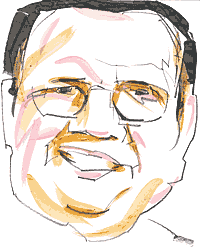Zealot Profile: Daniel A. Carp
Eastman Kodak Company Chairman and CEO
 |
|
Illustration by Thomas Libetti |
In 32 years at Eastman Kodak Company, Daniel A. Carp rose from statistical analyst to CEO of a multinational corporation that has been forced to change the nature of its business in order to survive. A company that had built its name on films and supplies for traditional photography found itself caught up in the digital revolution. Over the past decade, amid layoffs, sliding stock prices, and cutbacks, the $14 billion, 80,000-employee company has remade itself for a digital future. As president and COO for most of that time, and as chairman since the beginning of 2000, Mr. Carp has led a transformation of the organization. Today, half of the revenue of Kodak’s commercial division and a third of its consumer revenue come from digital products and services, and Kodak now has the largest online photo-imaging site. After September 11, Kodak announced the layoff of as many as 7,500 employees, more than double the number it had expected to let go because of the economic slowdown. With declines in travel, recreational photography fell dramatically. Hollywood cancelled planned releases of several films — meaning that tens of thousands of Kodak prints were never made. Third-quarter earnings after restructuring charges were 52 cents per share, as compared to $1.40 for the same period in 2000. Mr. Carp reflects on how to change a company’s mission in times of turmoil.
“My background was in the marketing and consumer side of the business, so my focus tends to be not so much on the technology as on the problem you’re trying to solve for your customer. Digital emerged slowly over time. I remember being in the research labs in the late ’70s and seeing the way digital was going to change the way consumers took pictures, the way pictures were distributed…. I thought, ‘This is great; we can solve more customer problems.’ I wasn’t smart enough to know this was going to be a major transformation for the company.
“You don’t transform a company yourself. The first thing you do is assemble a team of people who understand both the complexity of the business and the opportunity — they have to understand both the history and the future.
“The most important thing for the bottom line is having an organization that can supply customer product and solutions. The way you do that, frankly, is through people. People take raw materials and products and turn them into solutions for customers. It’s a joint effort on the part of the company and the employee to maintain good morale. Morale goes up and down depending on a number of factors — how the economy is doing, whether I can get my kids to school, if somebody in the family is sick. We do work on trying to keep morale high, but morale is also the responsibility of the worker. If I don’t come to work with good morale, I’m going to hold myself and my teammates back.
“The presidents and senior teams of each of our business units set their strategies, then break them down into specific goals for our 750 mid-managers. They break the goals and directions down to the people in their organizations. If you’ve got good management up and down the line, they will encourage people to solve the specific operational challenges. Most of our ideas on how to solve the everyday problems bubble up from the factory floor and the R&D bench. It’s an iterative process; you just keep working it.
“Back in early 2000, we all believed that there was a chance that the world had changed, that valuations were going to be driven on revenues and eyeballs rather than discounted cash flow. Now everyone’s an expert and can tell you that was crazy, but … I had plenty of advisors telling me to break out a tracking stock and go for the eyeballs and get a valuation for our currency and use the currency to buy something. [Senior executives] Willy Shih and Dan Palumbo and I said, ‘We’re not going to chase that.’ We made some investments through our venture-capital operation in things that might work, but we stayed the course of building our infrastructure and our understanding of customer behavior. We stayed with a model that says you get paid for what you do and you have to make a profit. When the bubble burst, we felt good about what we did. We weren’t visionaries; back then, we did think there was a chance that there was a new economic model in the world.” ![]()

